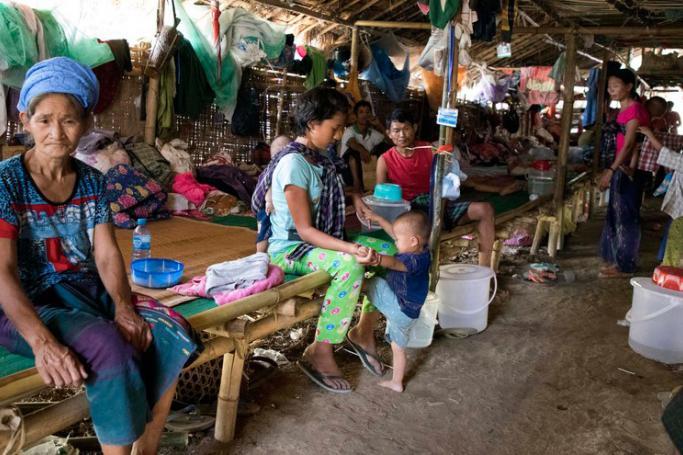Myanmar’s humanitarian crisis continues to worsen as the Myanmar military digs in its heels and threatens to “annihilate” opposition to their iron rule.
On the weekend, the military junta celebrated Armed Forces Day in Naypyidaw with the usual display of military might, with troops, tanks, missiles and aircraft, all used to target its own citizens.
The date of 27 March 2022 marked the 77th Armed Forces Day, the commemoration of the start of what is said to be the Burmese army's resistance to Japanese occupation in 1945.
As Myanmar junta leader Min Aung Hlaing said in a message for the day, the military will "no longer negotiate... and annihilate until the end" groups fighting to overturn its rule.
HOPES DASHED
The message was an unfortunate reminder of the damage decades of military rule has done to a country that on the cusp of independence in 1948 was referred to as the “Asian rice bowl” – with so much potential - but is now on the edge of becoming a “basket case,” according to international observers and critics.
During the early 20th Century, the territory of Burma offered promise that the newly-emerging nation that threw off British colonial rule had agricultural potential to such an extent that rice production would feed not only domestic consumers but could reach out globally with its exports. The country was said to be the leading world exporter of rice from 1961 to 1963.
But after a nominally socialist junta under General Ne Win seized power in a coup in 1962, decade after decade of military regime mismanagement shattered the agriculture industry in a nation where 70 per cent of inhabitants still live in the countryside, but where bullocks are still used by many farmers to till the fields.
For a short while, the quasi-civilian reformist government of Thein Sein, which took over from the military in 2011, and the subsequent elected National League for Democracy-led government under Aung San Suu Kyi sought to resurrect the country's reputation as a rice producer. Rotting stocks, creaking infrastructure, heavily indebted farmers and minimal foreign investment were among the hurdles faced, though there was some progress made with crop diversity, and some minimal mechanization.
What this meant was large segments of the population, particularly in rural areas, and in the ethnic states, teetered on the brink of poverty and insufficient nutrition. This was a situation compounded by the decades of conflict in the various ethnic states, and the displacement of populations – either as internally displaced people or as refugees.
A core tell-tale sign that all was not well in the Golden Land was the flood of Myanmar migrants into Thailand and other countries in the Southeast Asia region during the 1980s, 1990s and 2000s. This was a reflection of the poor state of Myanmar’s agricultural sector, as well as the economy as a whole.
Prior to the stifling COVID-19 pandemic restrictions, Myanmar migrants numbered about 5 million and were an important conveyor of income to their families back home.
TELLING SIGNS
Today, the existing long-term humanitarian crisis has grown worse as Myanmar suffers under a brutal coup-maker, compounding the damage done by two years of COVID-19 restrictions, and closed borders.
Warnings have been made by the United Nations and a host of non-governmental organizations on several levels.
The most obvious concerns revolve around the Myanmar military attacks against civilians, not just in the ethnic states – long subject to suffering – but also in Bamar-majority areas of the country. Core areas where displaced people or refugees pose a challenge include Sagaing, Magwe, and Chin, Shan, Karen, Kachin, and Karenni states. Although the UN Refugee Agency UNHCR and the World Food Progamme are attempting to provide food, shelter and medical supplies to the displaced, access is difficult or prohibited by the Myanmar military authorities.
The UNHCR has stepped up its emergency response to assist hundreds of thousands of internally displaced people (IDPs) in Myanmar as their number crossed the 800,000 mark – doubling since the February 2021 coup.
According to UNHCR spokesperson Matthew Saltmarsh, security is deteriorating rapidly across the country as fighting and armed conflict intensifies with no sign of abating. The UNHCR forecasts an accelerating trend of displacements in the coming weeks and months. Some 440,000 people have been newly displaced since February 2021, according to UNHCR data, adding to an existing 370,000 who had fled their homes previously.
UNHCR and partners are scaling up operations and deploying additional resources to support as many of the displaced as possible, complementing local community responses.
UNHCR spokesperson Saltmarsh says the southeast of the country, Kayin, Kayah, Mon and Shan (South) states as well as Bago (East) and Tanintharyi regions collectively account for more than half of the 440,000 newly displaced civilians. Kayin and Kayah states remain the most affected as hostilities between various armed groups have triggered large-scale displacements.
On a macro-level, a combination of the damaging COVID-19 pandemic restrictions over the last two years and the serious effects of the coup on the overall economy have severely hit employment and businesses in the country, and prompted several leading foreign investors to pull out. Foreign investors have come under pressure not to be seen to be supporting or helping directly or indirectly financing the Myanmar junta, accused of rampant human rights abuse.
What this means is that a substantial percentage of Myanmar’s population, particularly those on the lower rungs of society, are hovering around or below the poverty line. The United Nations estimates that close to 13 million people – out of a population of 54 million – now live below the poverty line. And the situation could get worse.
Myanmar, a country rich in resources, is teetering on the edge of a humanitarian catastrophe due to the ongoing and expanding civil war and collapsing economy, with worse news to come in the next few months.












